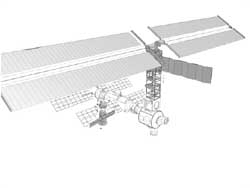
|
Flight 8 - 2R
- Launch Date:
- 2. Nov. 2000
- Launch Vehicle:
- Russian Soyuz Rocket
- Elements:
- Soyuz
|
- Establishes
first station manning with three-person crew: Commander Bill Shepherd;
Soyuz Commander Yuri Gidzenko; Flight Engineer Sergei Krikalev.
- Provides Russian ./img/assured crew return capability without the Space Shuttle present.
- Station
begins permanent human presence.
|
In July 1999, an international crew of three will begin living aboard the
International Space Station, starting a permanent human presence aboard the
outpost. The crew has been in training for the mission since late 1996 and
includes International Space Station Commander Bill Shepherd, a U.S.
astronaut; Soyuz Commander Yuri Gidzenko, a Russian cosmonaut; and Flight
Engineer Sergei Krikalev, also a Russian cosmonaut.
The first crew will spend five months aboard the International Space
Station. When they arrive, the station will consist of three modules: the
Russian Service Module, which will serve as living quarters and onboard
control center for the early station; the U.S.-funded and Russian-built
Zarya, a module that provides supplementary power and propulsion functions;
and the U.S.-built Node 1, a connecting module that provides the attachment
points for future U.S. segments.
The crew's mission will be a flight test of the new station as they ./img/assist
with critical assly activities from onboard. During their stay, three
Space Shuttle assly missions will dock, expanding the station by
delivering the first truss-based U.S. solar arrays, the U.S. Laboratory
Module and the station's primary robotic arm, built by Canada.
The crew will be launched on a Russian Soyuz spacecraft from the Baikonur
Cosmodrome in Kazahkstan. They will return at the end of their mission
aboard the Space Shuttle on assembly flight 6A, the mission that delivers
the robotic arm. They will be relieved by a new crew of three that will be
launched on the shuttle on flight 6A. The Soyuz spacecraft the first crew
rides to orbit will remain docked with the station, providing an emergency
return to Earth for crew members if needed. The Soyuz spacecraft attached
to the station will be changed out with a fresh spacecraft about each six
months to maintain the emergency crew return capability.
